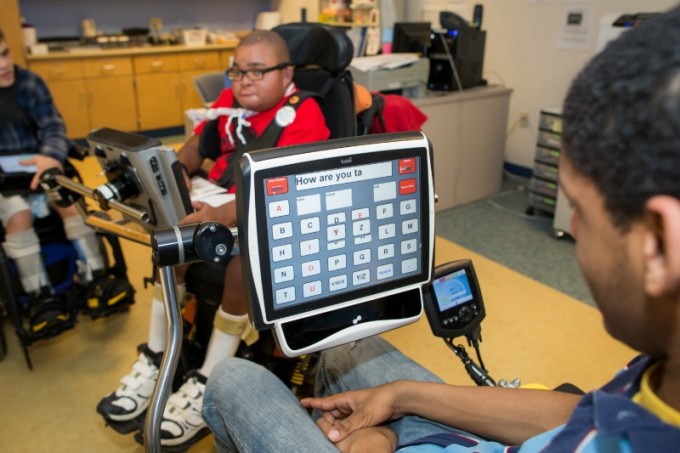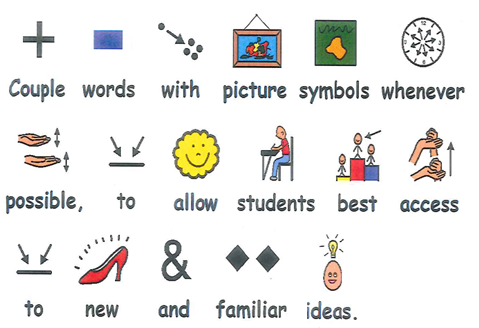Back-to-School Transition with Augmentative Communication and Assistive Technology
The Kennedy Day School, located onsite at Franciscan Hospital for Children, provides fully collaborative special education, therapeutic, and health services to students, ages 3 to 22, with significant, complex needs from more than 30 cities and towns across Massachusetts. If you have questions regarding the Kennedy Day School, please contact Lynne Goyuk at lgoyuk@fhfc.org or 617-779-1113.

For the past few weeks, students across Massachusetts have been settling into a new school year. Back-to-school comes with inevitable transitions that can be hard for children to handle – from changes in bedtime, to remembering what homework is like, to meeting new peers and teachers, and more.
Many families are familiar with these transitions, and are ready to handle any challenges that might come along with them. For our Kennedy Day School students and their families, easing into a new school can present similar challenges, but the ways in which they are handled differ.
The Kennedy Day School, located onsite at Franciscan Hospital for Children, provides fully collaborative special education, therapeutic, and health services to over 80 students, ages 3 to 22. Our program is uniquely designed to serve students with significant, complex needs including cognitive, developmental, physical, communication, medical and other challenges.
So what is a common thread in easing the back-to-school transition for our KDS students, staff, and families? Augmentative communication and assistive technology. Augmentative communication refers to the alternative communication methods that enable students with limited ability to produce speech the opportunity for effective interpersonal interaction. Many of our students also use assistive technology to enhance learning, communication, social interactions, and environmental control.
Let’s explore three areas in which these tools can be used to ease the challenges of a new school year for any student who utilizes augmentative communication and/or assistive technology as an aid to learning:
1. New information and updates.
It’s important to offer children ways to address and label new friends, peers, therapists and teachers so that they can start communicating with them right away. This could mean adding new or updated photographic representation on attendance boards, or programming photos into high-tech assistive communication devices as soon as possible.
Additionally, back-to-school is a great time to update any biographical information for the student. Has the child’s class number changed? Has his or her family moved? Is Justin Bieber SO last year and not a preferred music choice anymore? This is an opportunity to refresh that information.
2. Helping with transition.
Offering a student Social Stories* can help to illustrate the changes made in the new year. These stories are tangible representations which highlight the emotions that the student might be feeling surrounding the sense of loss that is often associated with change. Visuals enable students to refer to the book when feeling anxious, without needing an adult reader. Always highlight the positive changes associated with new adventures!
Balancing the old with the new can be difficult for children. Your student may want to ask about old friends, therapists, or teachers. It’s important to not throw out or permanently delete old photos, and to let the student know how to access them. This will eliminate frustration by providing the child a way to explain what’s bothering them. For example, if he/she is feeling anxious about a missing friend, they can let their teacher know. In many cases, the old friend might be right next door and the teachers can arrange a play date or interaction between the two old buddies.
3. Making new friends.
Everyone is nervous about meeting new people at the beginning of the year. For high-tech communication device users, program knock-knock jokes for the new student to share with their new classmates. Program trivia into sequential-step voice output communication devices to allow the student opportunities to meet (and stump!) school staff. Encourage students who use static visual displays to conduct surveys to figure out staff/pupil desired goals for the coming school year.
Below, you’ll find a Quick Tip Checklist from our Kennedy Day School staff to help ensure a smooth back-to-school transition.
- Daily checks to ensure that devices are charged and batteries are in those devices requiring them.
- Review of students’ individual communication devices and systems, as they vary by student (i.e. Student 1 = Head Switch, Student 2 = Head Switch/Step by Step Switch, Student 3 = iPad, etc.).
- Sharing of a child’s unique or idiosyncratic communication strategies (e.g., non-standard sign/word approximations) with new staff members to decrease frustration of students.
- Begin parent-school communication right off the bat! Checking in with families allows for a better understanding of the child, both academically and socially, especially for students that can’t easily tell us what they did that weekend or over the summer.

Overall, the trend in responses from staff encouraged the promotion of communication at all times between students, teachers, therapists, families, and anyone involved in the child’s education experience!
How does your family ensure a smooth back-to-school transition?
*For more information on Social Stories, please visit the Gray Center website here.
View All Blog Stories